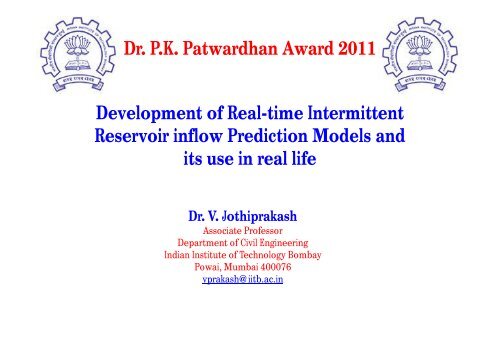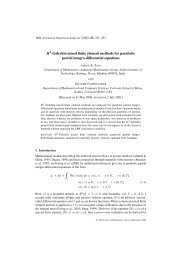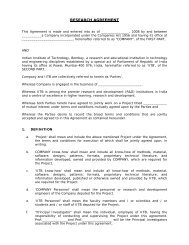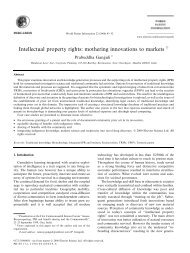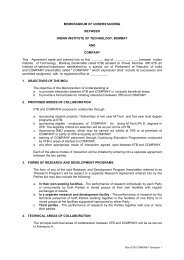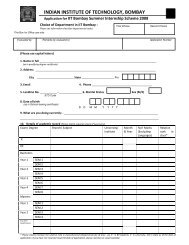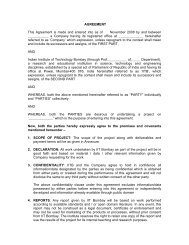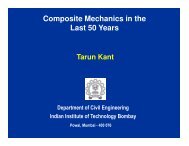Presentation - IRCC - Indian Institute of Technology, Bombay
Presentation - IRCC - Indian Institute of Technology, Bombay
Presentation - IRCC - Indian Institute of Technology, Bombay
Create successful ePaper yourself
Turn your PDF publications into a flip-book with our unique Google optimized e-Paper software.
Dr. P.K. Patwardhan Award 2011<br />
Development <strong>of</strong> Real-time Intermittent<br />
Reservoir inflow Prediction Models and<br />
its use in real life<br />
Dr. V. Jothiprakash<br />
Associate Pr<strong>of</strong>essor<br />
Department <strong>of</strong> Civil Engineering<br />
<strong>Indian</strong> <strong>Institute</strong> <strong>of</strong> <strong>Technology</strong> <strong>Bombay</strong><br />
Powai, Mumbai 400076<br />
vprakash@iitb.ac.in
Genesis <strong>of</strong> the present work<br />
Prior to<br />
IIT B<br />
After<br />
Joining<br />
IIT B<br />
MoWR/<br />
KRF<br />
Project<br />
• Worked in developing Reservoir Operation rule curves<br />
• Found that Reservoir inflow prediction plays major role in<br />
implementing the rule curves<br />
• Started Working in reservoir inflow prediction models<br />
• IIT B seed grant (Multi-site synthetic inflow generation using ANN Model)<br />
• DST Workshop (Application <strong>of</strong> Advanced S<strong>of</strong>t Computing Techniques in Geo-<br />
Spatial Data Analysis)<br />
• STTP on S<strong>of</strong>t computing techniques in Hydrology and Water Resources Engg<br />
• MoWR Sponsored Project (Derivation <strong>of</strong> operating rules for a multi-purpose<br />
reservoir using s<strong>of</strong>t computing techniques)<br />
• Real Time reservoir inflow prediction (3 PhD Scholar)<br />
• Derivation Reservoir Operating Rule (1 PhD Scholar)<br />
• Korean Research foundation R&D project (catchment classification/dimension<br />
study to generalize a catchment)<br />
2
Introduction<br />
• Altogether 100’s <strong>of</strong> prediction models using various techniques are<br />
available at national and international levels (as reported in national and<br />
international journals),<br />
– all the models are lying as published papers, there is no reported evidences <strong>of</strong><br />
models used in the field, in <strong>Indian</strong> Scenario.<br />
• In the present study the reservoir inflow models are developed using s<strong>of</strong>t<br />
computing techniques, namely Artificial Neural Networks, and Genetic<br />
Programming, and are converted into graphical user interface (GUI) to use<br />
it at field level.<br />
• After developing the GUI, the field engineers at dam site (Present study<br />
area is KOYNA RESERVOIR REAL TIME INFLOW PREDICTION) were trained to<br />
use the model.<br />
– After training, the field engineers validated the model and accepted the model<br />
before putting it in practical use.<br />
3
Major Research Gap (in process)<br />
‣ The dimensions required to model a rainfall-reservoir inflow processes is<br />
not studied in detail.<br />
‣ Many works on rainfall-run<strong>of</strong>f is available<br />
‣How many number <strong>of</strong> input data is required to develop rainfallinflow?<br />
– Dimensions <strong>of</strong> a model? Input to a model?<br />
‣The problem <strong>of</strong> time <strong>of</strong> concentration in rainfall-inflow ?<br />
‣Length <strong>of</strong> the data to be considered for developing the models?<br />
‣ The problem <strong>of</strong> having more number <strong>of</strong> continuous zero inflow values<br />
together with high variation in the data series has not been addressed in<br />
artificial intelligence modelling.<br />
4
Major Research Gap (in data used)<br />
• Scanty literature on the effect <strong>of</strong> using lumped and distributed<br />
data for reservoir inflow prediction on same catchment.<br />
– Assessment <strong>of</strong> the effect <strong>of</strong> different models based on<br />
lumped and distributed data set with different input<br />
combinations such as time-series, cause effect and<br />
combined models on multi-time-step reservoir inflow<br />
prediction has not been reported in the literature.<br />
5
Major Research Gap (in techniques)<br />
• Stochastic models assume normality and stationarity <strong>of</strong> the variables<br />
– Extreme or peak inflows are poorly mapped<br />
• Most <strong>of</strong> the research in application <strong>of</strong> ANN for Rainfall run<strong>of</strong>f dealt<br />
with<br />
– Mostly event based study<br />
– Few works on multi-step-ahead forecasting<br />
– Very few works on applications for daily continuous and hourly<br />
seasonal time-series<br />
• Few application <strong>of</strong> ANFIS, MT and GP for cause-effect and time series<br />
modeling<br />
6
Koyna Reservoir inflow prediction<br />
Methodology Flow Chart<br />
Stage-I<br />
Daily multi-time-step ahead reservoir<br />
inflow prediction- with continuous<br />
lumped and distributed data<br />
<br />
<br />
Daily inflow prediction models for<br />
Koyna reservoir ARIMA, MLR,<br />
ANN, ANFIS and LGP techniques<br />
for lumped and distributed (full year<br />
continuous 47 years) data.<br />
Select the best model from both daily<br />
lumped and distributed data<br />
Stage-II<br />
Development <strong>of</strong> an IUH for the Koyna<br />
reservoir.<br />
Hourly multi-time step ahead reservoir inflow<br />
prediction -With lumped and distributed data<br />
<br />
Hourly multi-time step reservoir inflow<br />
prediction models for Koyna reservoir<br />
using MLR, ANN, ANFIS and LGP<br />
techniques for lumped and distributed<br />
(seasonal 4 years) data.<br />
Select best model from both hourly lumped<br />
and distributed data<br />
Stage-III<br />
To develop and test GUI for both multi-time step daily and hourly reservoir inflow prediction<br />
based on best daily and hourly model. Testing data set (2008-2010) for daily data and (2009<br />
-2010) for hourly data. For actual use on dam site<br />
7
Study Area - Koyna Reservoir<br />
8
Plot <strong>of</strong> hourly rainfall and hourly inflow<br />
(1 Jun 2005-31 Oct 2008)<br />
9
Generalized Feed forward ANN<br />
A<br />
Easy way to<br />
explain ANN<br />
P (t-2)<br />
Q (t+2)<br />
P (t-1)<br />
Q (t+4)<br />
Q (t+6)<br />
P (t)<br />
Q (t-1)<br />
Q (t+8)<br />
Q (t)<br />
Q (t+10)<br />
Input layer Hidden layer Output<br />
layer<br />
Connections can jump over one or more layers,<br />
allowed to cross the hidden layer, i.e. output<br />
layer will get the input from the hidden layer and<br />
directly from input layer also<br />
10
Linear Genetic Programming (LGP)<br />
Generate the set <strong>of</strong> initial population. The individuals in the<br />
populations will be computer programmes<br />
≈<br />
Generation<br />
Evaluate the parse tree and assign the fitness. The fitness refers<br />
to how best the generated solution matches with the environment<br />
≈<br />
Parse Tree<br />
Form temporary population, select, and the candidates according to<br />
their fitness.<br />
≈<br />
Population<br />
Choose pairs <strong>of</strong> parse trees from the temporary mating pool<br />
(according to their fitness, normally) for mating and apply the<br />
genetic operation called ‘crossover’.<br />
≈<br />
Cross Over<br />
Apply another genetic operation called as ‘mutation’ which<br />
randomly changes the genetic information <strong>of</strong> a candidate.<br />
≈<br />
Mutation<br />
Copy the resulting ‘chromosome’ into the new population<br />
≈<br />
Fitness<br />
Evaluate the performance <strong>of</strong> new population<br />
≈<br />
Performance<br />
Evaluation<br />
No<br />
Is termination criteria is<br />
reached<br />
Yes<br />
Stop<br />
11
Daily lumped data model performance during training and<br />
testing - 1 day lead period – results<br />
19/8/2011<br />
Scatter plot best lumped data model (a) MLR (b) TDRNN (c) ANFIS (d) LGP<br />
12
Daily distributed data model performance during training<br />
and testing - 1 day lead period – results<br />
19/8/2011<br />
Scatter plots distributed data<br />
best model in each case (a)<br />
MLR (b) TDRNN (c) ANFIS (d)<br />
LGP during testing<br />
13
Hourly lumped data model performance during<br />
training and testing results ( 2 hr lead period)<br />
Training<br />
Testing<br />
Model<br />
R RMSE E % MF R RMSE E % MF<br />
19/8/2011<br />
HL -MLR Model (4 inputs) 0.82 262.52 0.79 19.45 0.79 270.52 0.75 23.21<br />
HL-ANN Model (5-7-7-5) 0.93 113.08 0.88 12.45 0.91 113.08 0.81 11.39<br />
HL-ANFIS Model (5 inputs) 0.95 79.09 0.90 10.45 0.93 80.43 0.87 9. 54<br />
HL-LGP Model (4 inputs) 0.98 75.76 0.95 -5.47 0.97 77.81 0.93 8.81<br />
Scatter plots <strong>of</strong> observed<br />
and predicted 2 hr ahead<br />
inflow (a) MLR (b) ANN (c)<br />
ANFIS (d) LGP<br />
14
Hourly distributed data model performance during training<br />
and testing results (2 hr lead period)<br />
19/8/2011<br />
Scatter plots <strong>of</strong> observed and predicted 2 hr ahead inflow (a) MLR (b) ANN (c)<br />
ANFIS (d) LGP<br />
15
Novelty considered in the model<br />
• Appropriate length <strong>of</strong> data required to develop a<br />
hydrologic prediction model<br />
• Appropriate selection <strong>of</strong> type <strong>of</strong> model<br />
– by statistical performance measures<br />
• Appropriate modifications in the model to predict the<br />
peak inflows<br />
• Appropriate methodology to handle longer length <strong>of</strong><br />
continuous zero values in the time series<br />
– Data pre processing<br />
• Consideration <strong>of</strong> time <strong>of</strong> concentration in the large<br />
scale flood retention reservoirs for their inflow<br />
prediction<br />
– Distributed-lumped / multi-time-step-ahead including the<br />
time <strong>of</strong> concentration<br />
16
Novelty in application <strong>of</strong> the developed technology to implement<br />
in real life for reservoir inflow prediction<br />
Selection <strong>of</strong> appropriate model<br />
Development <strong>of</strong> GUI<br />
Development <strong>of</strong> GUI<br />
Vigorous test and verification at Lab<br />
<strong>Presentation</strong> and demo at Dam site<br />
Hands-on training to dam authorities<br />
Validation <strong>of</strong> s<strong>of</strong>tware by dam authorities<br />
Use <strong>of</strong> s<strong>of</strong>tware in real life for inflow prediction
Graphical user interface (GUI)<br />
Splash Screen<br />
18
Main module <strong>of</strong> GUI<br />
19
Training Program Photos at Dam <strong>of</strong>fice
Statistical performance <strong>of</strong> daily observed and 1 day ahead predicted<br />
inflow during validation and real-time forecasting period (2008-2010)<br />
Statistical<br />
properties<br />
Observed<br />
inflow (10 6 m 3 )<br />
Predicted<br />
inflow (10 6 m 3 )<br />
%<br />
error<br />
Mean 9.49 9.62 1.37<br />
Std. Dev. 24.83 24.18 -2.62<br />
Kurtosis 27.45 25.56 -6.88<br />
Skewness 4.58 4.34 -5.24<br />
300<br />
300<br />
Inflow (10 6 m 3 )<br />
250<br />
200<br />
150<br />
100<br />
50<br />
(a)<br />
Observed inflow<br />
Predicted inflow<br />
Predicted inflow (10 6 m 3 )<br />
250<br />
200<br />
150<br />
100<br />
50<br />
(b)<br />
0<br />
1/1/2008<br />
4/1/2008<br />
7/1/2008<br />
10/1/2008<br />
1/1/2009<br />
4/1/2009<br />
7/1/2009<br />
10/1/2009<br />
1/1/2010<br />
4/1/2010<br />
7/1/2010<br />
Time in Days (1 Jan 2008 to 31October 2010)<br />
0<br />
0<br />
50<br />
100<br />
150<br />
200<br />
250<br />
Observed inflow (10 6 m 3 )<br />
300<br />
(a) Time-series and (b) scatter plot <strong>of</strong> observed and predicted inflow<br />
during validation and daily real-time forecasting period (2008-2010)<br />
21
Statistical performance <strong>of</strong> daily observed and 2 hr ahead predicted<br />
inflow during validation and real-time forecasting period (2008-2010)<br />
4000<br />
4000<br />
Inflow (m 3 /sec)<br />
3500<br />
3000<br />
2500<br />
2000<br />
1500<br />
1000<br />
500<br />
(a)<br />
Observed inflow<br />
Predicted inflow<br />
Predicted inflo w (m 3 /sec)<br />
3500<br />
3000<br />
2500<br />
2000<br />
1500<br />
1000<br />
500<br />
0<br />
(b)<br />
0<br />
1<br />
426<br />
851<br />
1276<br />
1701<br />
2126<br />
2551<br />
2976<br />
3401<br />
3826<br />
4251<br />
4676<br />
5101<br />
5526<br />
5951<br />
6376<br />
6801<br />
7226<br />
0 500 1000 1500 2000 2500 3000 3500 4000<br />
Observed inflow (m 3 /sec)<br />
Time in hours (1 June 2009-12.00hrs to 31 Octobr 2010-23.00 hrs)<br />
(a) Time series and (b) Scatter plot <strong>of</strong> observed and predicted inflow during<br />
validation and hourly real-time forecasting period (2009-2010)<br />
22
Use <strong>of</strong> GUI in real life<br />
23
19/8/2011<br />
24
• Economic benefit<br />
– The accurate estimation <strong>of</strong> inflow is useful for estimating<br />
the water releases from the dam for various purposes<br />
like power production, irrigation and industrial use.<br />
Especially the flood release, which is directly affecting<br />
the Sangli City. There is large amount <strong>of</strong> intangible<br />
benefits.<br />
• Industrial Utility<br />
– The present models and GUI can be converted into a<br />
adaptive mode models and can be used at any<br />
intermittent reservoirs.<br />
• Work in Progress<br />
– Catchment classifications – to generalise the work<br />
– Need to apply for patent after this step.<br />
25
Students Involved<br />
• Research Scholars:<br />
1. Dr. Alka S. Kote,<br />
2. Dr. R.B. Magar,<br />
3. Mr R. Arunkumar<br />
4. Ms. Fathima T. A.<br />
• M. Tech Students:<br />
1. Mr. Sunil Kalkutti,<br />
2. Ms. Dipali More<br />
• B.Tech Students:<br />
1. Ms. Nilesh Priya,<br />
2. Mr. Mayank Dobhal,<br />
3. Mr. Mayank Mehta,<br />
4. Mr. Nirdesh Kumar,<br />
5. Ms. Harpreet Kaur<br />
• Summer Internship Students:<br />
1. Tirupan Mandal<br />
26
Other Awards<br />
• ISTE-Maharashtra State National Award for Research Work in<br />
Engineering and <strong>Technology</strong> for the year 2011 awarded by <strong>Indian</strong> Society<br />
for Technical Education, during the 41 st Annual Convention <strong>of</strong> ISTE held at<br />
Fatehgarh Sahib, Punjab on 16 th Dec 2011. (for overall work on the<br />
Reservoir inflow prediction)<br />
• The Union Ministry <strong>of</strong> Water Resources: Department <strong>of</strong> Irrigation Prize<br />
awarded by Institution <strong>of</strong> Engineers (India) for the paper published in Civil<br />
Engineering Division, during the 25 th <strong>Indian</strong> Engineering Congress held at<br />
Kochi on 17 th Dec. 2010. (for the paper co-authored with Dr. Alka S. Kote,<br />
listed as number 5 in the list <strong>of</strong> publication)<br />
• Dr. Magar’s PhD thesis has been selected for the Excellence in Thesis<br />
Work, IIT <strong>Bombay</strong>, the awarded during the 50 th Convocation, 2012.<br />
27
• Published<br />
International Journals 10<br />
National Journals 06<br />
International Conferences 07<br />
National Conferences 26<br />
Total 49<br />
Publications<br />
• Submitted<br />
International Journals 08<br />
National Journals 07<br />
International Conferences 01<br />
National Conferences 02<br />
Total 18<br />
28
Acknowledgements<br />
• <strong>IRCC</strong> –IITB – seed grant<br />
• DST- Workshop<br />
• MoWR – R& D Project<br />
• Korean Research Foundation-R&D Project<br />
• Chief Engg, Exec. Engg Koyna Dam Irrigation<br />
and Maintenance Division and Kukadi project<br />
– for data and support and for using our<br />
models today<br />
• Research Scholar : Alka Kote, Magar,<br />
Arunkumar, Fathima and others
Thank you<br />
30


